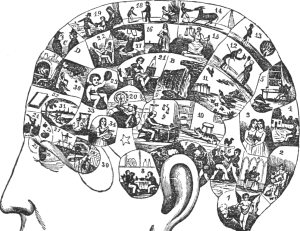 Could phrenology be true after all? The nineteenth century theory that bumps on the head correlated with personality traits has always been dismissed as absurd by most, right from its earliest days. Perhaps because of this, it has rarely received serious attention; but now O. Parker Jones, F. Alfaro-Almagro and S. Jbabdi have given it a properly rigorous examination, exploiting the resources of the UK Biobank.
Could phrenology be true after all? The nineteenth century theory that bumps on the head correlated with personality traits has always been dismissed as absurd by most, right from its earliest days. Perhaps because of this, it has rarely received serious attention; but now O. Parker Jones, F. Alfaro-Almagro and S. Jbabdi have given it a properly rigorous examination, exploiting the resources of the UK Biobank.
Phrenology was based on ideas that are reasonable in themselves. First it supposes that different regions of the brain have different functions, following a consistent pattern in all humans. Second, it holds that if one of those functions plays an especially large part in a subject’s mental life, the relevant area will be larger, and tend to swell outwards. Third, these swellings in the brain will be reflected in the shape of the skull, in a way which can be detected by careful measurement, or through palpation by a skilled phrenologist. These propositions may be wrong, but cannot be dismissed as inherently nutty.
Phrenology used a list of ‘faculties’ such as ‘amativeness’ and ‘philoprogenitiveness’, which mapped on to areas of the brain; the charts and models which resulted have a strange appeal and are still often used ornamentally by people who have no belief or even interest in the theory they embody. There were 27 faculties in all; some of them look a little odd (number 5 is ‘Murder, carnivorousness (Destructiveness)’ which even vegetarians might accept is a rather heterogeneous grouping), but most make prima facie sense. In order to test the theory, the researchers tried to match up the faculties with ‘lifestyle’ measures available in the Biobank data. It has to be said that some of these matches are better than others. Linking ‘amativeness’ with number of sexual partners, or the number faculty with mathematicians, seems reasonable: linking combativeness with solicitors, and self-esteem with bankers is possibly more debatable. The proposed linkage of cautiousness with frequency of alcohol intake must sure;y be intended as a negative correlation. The researchers confess that their choices here reflect their own faculty of mirth to some degree. In general, it seems the researchers did not end up using the job-related lifestyle measures, because there just weren’t, for example, enough poets in the data.
In some cases there were strong correlations across faculties/lifestyle measures. Mostly these seem to have been unsurprising – writers, it turns out, tend to be good with words. More amusingly, the strongest correlation was between the ability to generate words and the number of sexual partners. If you want many partners, it seems you should be hanging out at poetry slams, not the gym.
It will perhaps come as no surprise that the researchers found no correlation between the faculties and skull curvature. This is enough, with appropriate caveats, to show that ‘orthodox’ phrenology is incorrect. We sort of knew that already; as the paper points out, studies based on the deficits caused by brain lesions in particular areas long ago showed that while there was indeed localisation of function within the brain, the functions were not where phrenology said they ought to be. However, it leaves open the possibility that a reformed phrenology, with a different set of faculties, might still be sound.
This remaining possibility is removed by the second part of the study, which confirmed that there is no correlation between the bumpiness of the brain and the bumpiness of the skull. You cannot tell anything about the brain inside just by feeling the head that contains it. This too isn’t really a huge surprise. If the shape of the skull were determined by the shape of the brain, we might expect our heads to show visible signs of the different lobes that make up the large-scale structure of the brain; we might expect that the skull would be skewed the way the brain is, with one hemisphere edging ahead of the other.
However, as the researchers rightly say, it is good to have these things tested with proper scientific rigour. They also suggest that their techniques might have some value in certain real medical conditions where the brain is at risk of being constrained by the skull. I suppose it’s useful, too, to be reminded how popular a theory with no real scientific basis can become (not that we’re in much danger of forgetting that these days…).
